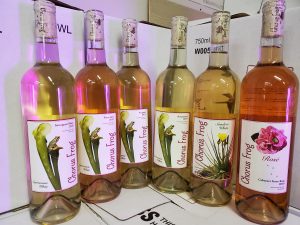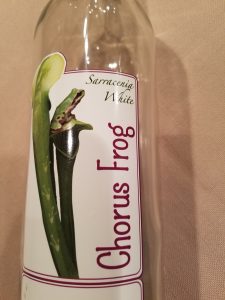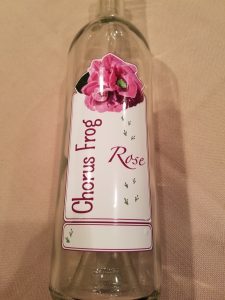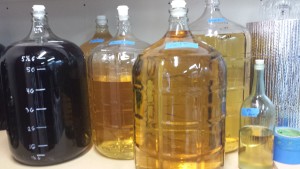April update….
In my last update, I was retesting the SG, pH, and TA of all my wines and making sure that all of my equipment was truly clean for the season. Well I found out that my syrah had not finished with the primary fermentation; it was “stuck”. I have syrah in three different containers, the specific gravity (SG) readings were, Tank #1 1.010, Tank #2 1.001 and #3 1.006. This is a big spread from the same batch of grapes.
So why was the syrah stuck? I think the main reasons are that the brix were too high, at about 27. I should have watered the wine down to 24. In addition, I was out of town and was not monitoring and feeding the yeast, as I should have been. I quickly made a few calls to confirm what my next step should be, and all agreed that I needed to do a restart. I have never done a restart before so I went to Winemaker Magazine.com and to Scott Labs.com to find the best procedure. Scott Labs had a good print out for the step-by-step procedure. Both web sites said the same thing but Scott Labs was easier to follow.
I will just give a quick overview of what I did. I am not giving amounts, because they are based on volume of the wine. So my numbers are based on my volumes. First, I added yeast hulls to help remove toxins from the wine 24 to 48 hours before the restart. When yeast struggles to finish due to bad conditions, they produce unwanted compounds in the wine. After the 48 hours I racked it off the lees. Next, add half as much yeast hulls and start hydrating the yeast. The recommended strain for this is Uvaferm 43. This is where you need to read the steps carefully because this yeast is going into a low sugar, high alcohol environment and you do not want to overfeed the yeast. The next step is a slow process designed to prevent the yeast from going into shock in this high alcohol low sugar environment.. I mixed a small amount of wine into the yeast and waited 20 min. Then I added 5% of the wine volume and an equal volume of water into the restart bucket and added yeast starter. Wait 30 min add 10% of wine volume, wait 30 min add 20%, and wait 30 min repeat this until all the wine is in the new fermenter. The wine should be warm, about 70° F or more; the range for this yeast is 56-95°F.
I had no clue how long this was going to take or how long it should take. There is no big foaming head, just a few small bubbles each day. However, this is how it went for me and the temperature was about 65-75°F. Make sure to correct for temperature with the hydrometer. Warmer wine is less dense than cold wine and most hydrometers are calibrated to 60° F.
#1 start 1.010, 1 wk,1.008, 2wk 1.007 3wk 1.005
#2 start 1.001, 1wk 0.999, 2wk 0.999, 3wk 0.999
#3 start 1.006, 1wk 1.004, 2wk 1.004, 3wk 1.001
Tank #2 got to dry”0.999″,but there is most likely still residual sugar in the wine, so I quickly put it back into the tank to protect from oxygen. But what to do about the other two batches of wine? Well, I was planning on making a Cab-Syrah-Merlot blend anyway so I thought, why not now? I had a small blending party to get some input on what percentages to do and this is what we came up with, tank #1 69% Syrah 15% Merlot and 16% Cab Sav. Batch #3 70% Syrah 13%Merlot 17% Cab Sav. Both the Syrah and Cab Sav are 2014 and the Merlot is from 2013. I blended the wines hoping that the blend would drop the SG some more and give it more acid, but wanted to wait a week to give it time to work things out while I was out of town. One week later, it was time to check on the wine and to my surprise, the two blended batches of wine were bubbling away. “It’s fermenting again!”
I had to wait a few more weeks for the bubbling to stop. I now have the results for tank #1 and batch #3. Tank #1 the SG is now 0.995 and a pH of 3.79. I am adding 50 ppm SO2 and adding tartaric acid in small doses until the pH and taste is where I want them. Batch #3 the SG is now 0.994 with a pH of 3.81, I will do the same as I did with tank #1 with the SO2 and acid.
I am not sure what the future will be for tank #2. I need to buy a clinitest to test how much residual sugar is still in the wine. I may bottle some of it as an almost off dry wine and save the rest for blending with next year’s grapes. If I do that, I will add it before new grapes are done fermenting so that any sugar in the syrah can be converted.




